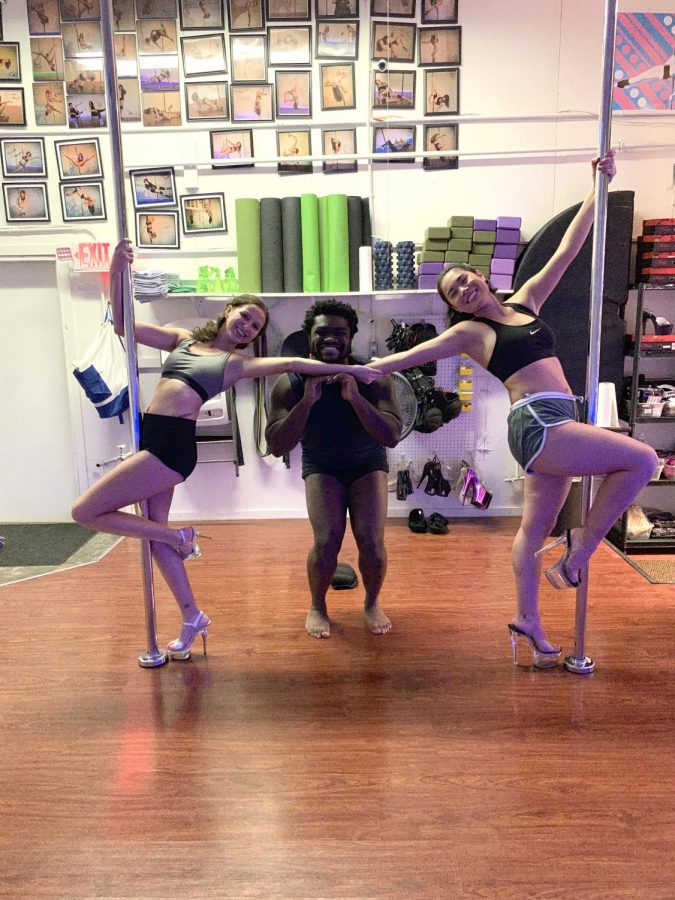The Review’s Sports Editors Went Pole Dancing, and It Was Difficult
This week, the Review’s sports editors decided to attempt an athletic endeavor known for its test of strength and agility, as well as its controversial recent popularization as a fitness practice: pole dancing. The Cleveland area has a number of locations that offer pole dancing classes as a form of exercise, and after extensive research, we settled on Expressions Fitness’ Beginner Level 1 & 2 class in Berea, OH.
As sports editors and recreational athletes, we felt confident going into the class. But even Khalid McCalla, our contributing sports editor and a former Division-III varsity football player, was breaking a sweat just ten minutes into the class. We were very naive.
Pole dancing is physically demanding and nothing like we had ever done before. Not only were we tasked with lifting the whole of our body weight onto a sleek pole by the strength of our shoulders, wrists, and occasionally legs, but we were also told to do so as beautifully and gracefully as possible. The most basic movements and forms resulted in sweat, muscle strain, and body contortion that we had never experienced before.
It was no surprise that our class instructor, Melissa Greenwood, told us that she connected with pole dancing through her previous experience as a competitive gymnast, and found that pole dancing was a great way to access the physicality of gymnastics.
“I was a gymnast for the longest time,” Greenwood said. “Once a gymnast, always a gymnast. I wanted to find something that challenged me physically that wasn’t just running on a treadmill or lifting weights.”
Pole dancing is an acrobatic art often associated with sex work, and only more recently with fitness and athleticism. Its origins date back 800 years to India, where acrobats used a pole to show off their athletic prowess in a more rigid, straightforward manner. By the early 20th century, however, pole dancing was sexualized by the Western world with the introduction of exoticized sideshow acts, where it was exhibited with burlesque and belly dancing. It has since been adopted by sex workers, who are known to showcase pole dancing in strip clubs.
Prior to taking the class, we researched proper pole dancing etiquette. We discovered that wearing as little clothing as possible was not only a common practice but also necessary in order to stay on the pole — the direct contact between the smooth surface of the pole and skin creates the friction needed to stay in control of our bodies and elevated off the ground. In class, we found out that extremely high heels — no less than five inches tall — make even the slightest of movements more dramatic and provide support for proper footing both on and off the pole.
The heels also had the added benefit of allowing us to channel confidence. It was fun to express ourselves in ways that we hadn’t done before, and access a sensuality that is rarely shared in a public setting. Leaving the class, we understood why pole dancing is often seen as a means to empower its participants.
“When I first started pole [dancing], I said — [because] I’m a gymnast — ‘I’m never going to own a pair of heels, and I’m never going to take a sexy class,” Greenwood said. “‘It ain’t gonna happen, ever.’ Once I took a few general dance classes — and they were a little bit more on the sensual side — it was freeing to allow myself to see a different side of who I am, in a world of confidence. In the world of pole [dancing], there’s a lot of women that come here looking for confidence, and once you’re allowed to feel yourself physically and emotionally, it can be freeing. And once you bring a bit of your sensual side to it too, it enhances the experience.”
Many of the class’s participants were regulars and knew each other closely. The inviting atmosphere of pole dancing clearly fostered a strong community for a variety of people. The owner of Expressions Fitness, Tiffany Curtin, explained that the community is her favorite aspect of the pole dancing experience.
“I meet the coolest, most amazing humans,” she said. “I meet a lot of doctors that do pole dancing, and a lot of people of all genders. … I think at the end of the day, because of the way pole [dancing] is perceived in the United States, you only get the most evolved, smart people that are strong enough on the inside to do what’s right for them and realize that this thing that we have going on is really amazing.”
The rising popularity of pole dancing as a form of fitness, however, has not arrived without controversy. Pole dancing is often deemed indecent, degrading, and hypersexual due to its ties to sex work. While pole dancing as a form of fitness has also been subject to this type of criticism, it was recently provisionally recognized as a sport through its “observer status” by the Global Association of International Sports Federations. The fitness side of pole dancing is experiencing a separation from pole dancing for a living, though, as shown by the “#notastripper” social media campaign in 2015 and 2016, which involved many people taking to various social media platforms to show that pole dancing can be a hobby or fitness regimen not confined to sex work. Though the campaign aimed to destigmatize pole dancing, it was considered offensive to sex workers.
In an interview with Vice, University of Southern California Labor, Sex Work, and Public Policy lecturer Heather Berg explained the harm in the widening gap between pole dancing as fitness and sex work.
“This has serious implications for sex workers in general, since it reinforces the idea that sex work means violence and degradation, thereby naturalizing violence when it does happen,” Berg said.
Greenwood is also well aware of the growing division between the two fields of pole dancing. She expressed that pole dancing should be a resource for all, regardless of whether it be for fitness or a living income, and that all those who partake should be respectful.
“For me, I believe that if you are comfortable with [stripping for a living] and that style of work, then do it,” Greenwood said. “Some women here [at Expressions Fitness] strip for a living, so they take classes for personal reasons, therapy, and dancing, but they also take it for exercise towards work. It’s your preference, it’s your world. If someone enjoys it, and that’s what they want to do, then I can’t see a problem with it.”









